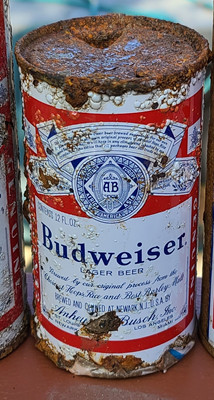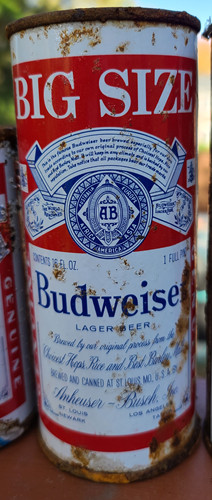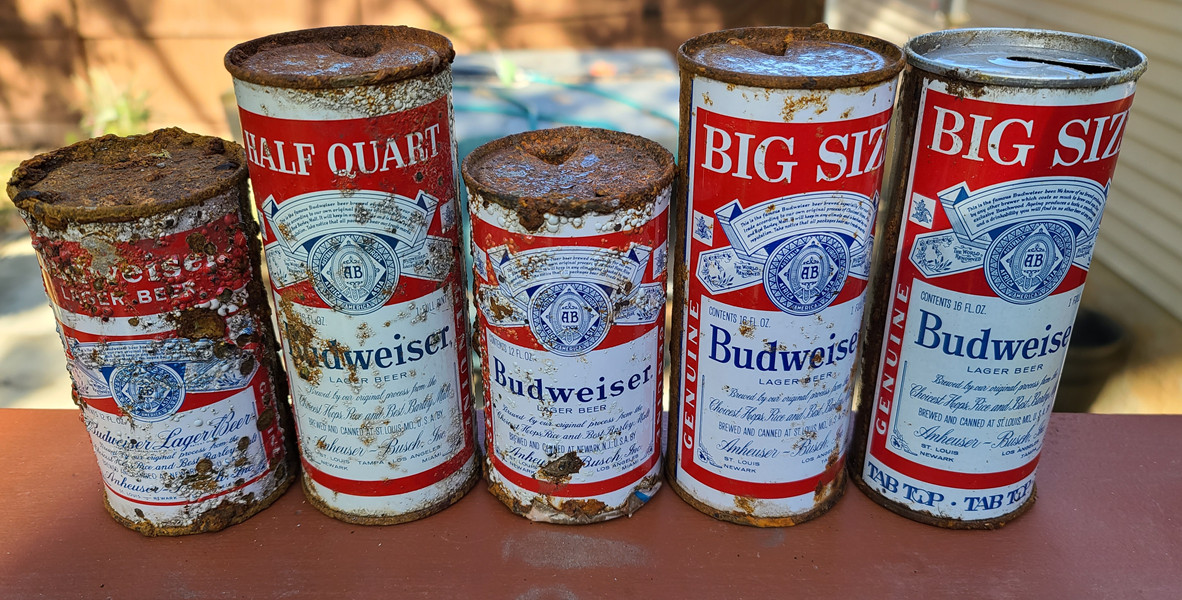Dumper Buds
This month's COM was inspired by a post on the Rusty Bunch Facebook page where a dumper asked for help “dating a can” he had just  dug. That led to remarks such as “buy it flowers” and “take it out for a nice dinner.” But one of the enjoyable parts of digging cans is trying to figure out how old a can is, and the age of the dump you are digging.
dug. That led to remarks such as “buy it flowers” and “take it out for a nice dinner.” But one of the enjoyable parts of digging cans is trying to figure out how old a can is, and the age of the dump you are digging.
Some cans are easy. Lucky and other west coast brewers used to stamp a specific date on the bottom showing when the can was filled. Other breweries used a more subtle code, although the early Ballantine code is easy to read once you know how. American Can Company put a date code along the seam showing when the can was manufactured, but it’s very tiny, and often unreadable if the can is not in very good condition. Going through the old brewing industry journals can help as they often had small blurbs about a brewery changing its label. Old advertising industry journals can also help showing which breweries won contests for new label designs.
This time though, I want to look at dating one of the brands that, for obvious reasons, is very common--Budweiser. Not only has it long been, if not the largest, one of the top two or three biggest breweries in the US, but starting in the 1950s Anheuser-Busch’s Budweiser cans have a white and red paint scheme that seems to weather the elements far better than most other cans of the era. It’s not uncommon to find a bunch of Budweiser flat tops in good condition along with other more desirable labels in far worse shape.
Anheuser-Busch did not stamp a specific date on each can, but beginning in 1951 they began adding brewery locations as they expanded. Even better, they listed the brewery locations at the bottom of the front label! From 1951 to 1970 they added the following breweries to their existing facility in St. Louis. (Of course they have added others since.)
Newark, New Jersey (opened 1951)
Los Angeles, California (opened 1954)
Miami (1958-1961)
Tampa, Florida (opened 1959)
Houston, Texas (opened 1966)
Columbus, Ohio (opened 1968)
Jacksonville, Florida (opened 1969)
Merrimack, New Hampshire (opened 1970)
Let's see how this works. If you find a Budweiser can that lists breweries in St. Louis and Newark, it came out between 1951 and 1954. Of course you can also go through old ads to see when the labels changed designs, but the brewing location list on the label is an easy-to-find reference point, especially if you are in a dump digging away without easy access to your reference material. I also use it a lot to answer emails I get from my website from non-collectors. Someone finds an Anheuser-Busch can in the wall of a home or in the attic, and want to know how old it is. The label lists Houston but not Columbus? It’s from 1966-1968.
Now take a look at the brewery locations on this example I dug in Maine.
 |
This can lists Tampa but not Miami and not Houston. Tampa opened in 1959, Miami closed in 1961, and Houston opened in 1966. That means it was filled between 1961 and 1966.
Try it yourself using these cans. When were they each filled? (Answers at the bottom of the page) The 16 oz all came from the same dump in Maine and the two 12 oz from the same spot in Massachusetts. Both dumps were near fishing lakes.
 |
Schlitz did the same thing, expanding to new locations, as did Falstaff, Carling, and other breweries. If you know when their brewing locations opened and closed you can find when the can was issued. Yes, there are other ways, but I like this one, simply because it reflects the history of the brewing industry, tracing the expansion of the larger breweries across the US in the decades after 1945. And that is why I love this hobby so much, discovering how the cans I find reflect that fascinating (to us anyway) history of American brewing. So the next time you see an old can from one of the big nationals, or one of the regionals trying to become a national, look at the label and look for how it reflects the history of that brand in subtle as well as obvious ways.
Answers:
1. 1954-1957 Probably from early in this date range due to the label design
2. 1959-1961
3. 1959-1961
4. 1961-1966
5. 1961-1966.
Number 4 is a flat top and #5 is a zip top. So that means #4 probably is from 1961-1963 and #5 is from 1963-1966.
